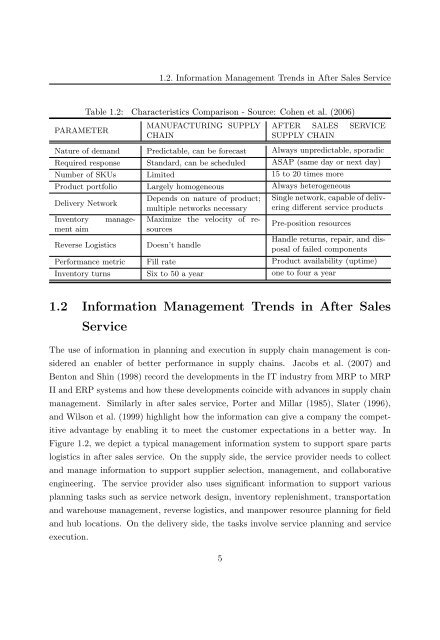Customer Information Driven After Sales Service ... - RePub
Customer Information Driven After Sales Service ... - RePub
Customer Information Driven After Sales Service ... - RePub
You also want an ePaper? Increase the reach of your titles
YUMPU automatically turns print PDFs into web optimized ePapers that Google loves.
PARAMETER<br />
1.2. <strong>Information</strong> Management Trends in <strong>After</strong> <strong>Sales</strong> <strong>Service</strong><br />
Table 1.2: Characteristics Comparison - Source: Cohen et al. (2006)<br />
MANUFACTURING SUPPLY<br />
CHAIN<br />
AFTER SALES SERVICE<br />
SUPPLY CHAIN<br />
Nature of demand Predictable, can be forecast Always unpredictable, sporadic<br />
Required response Standard, can be scheduled ASAP (same day or next day)<br />
Number of SKUs Limited 15 to 20 times more<br />
Product portfolio Largely homogeneous Always heterogeneous<br />
Delivery Network<br />
Depends on nature of product;<br />
multiple networks necessary<br />
Single network, capable of delivering<br />
different service products<br />
Inventory<br />
ment aim<br />
manage- Maximize the velocity of resources<br />
Pre-position resources<br />
Reverse Logistics Doesn’t handle<br />
Handle returns, repair, and disposaloffailedcomponents<br />
Performance metric Fill rate Product availability (uptime)<br />
Inventory turns Six to 50 a year one to four a year<br />
1.2 <strong>Information</strong> Management Trends in <strong>After</strong> <strong>Sales</strong><br />
<strong>Service</strong><br />
The use of information in planning and execution in supply chain management is considered<br />
an enabler of better performance in supply chains. Jacobs et al. (2007) and<br />
Benton and Shin (1998) record the developments in the IT industry from MRP to MRP<br />
II and ERP systems and how these developments coincide with advances in supply chain<br />
management. Similarly in after sales service, Porter and Millar (1985), Slater (1996),<br />
and Wilson et al. (1999) highlight how the information can give a company the competitive<br />
advantage by enabling it to meet the customer expectations in a better way. In<br />
Figure 1.2, we depict a typical management information system to support spare parts<br />
logistics in after sales service. On the supply side, the service provider needs to collect<br />
and manage information to support supplier selection, management, and collaborative<br />
engineering. The service provider also uses significant information to support various<br />
planning tasks such as service network design, inventory replenishment, transportation<br />
and warehouse management, reverse logistics, and manpower resource planning for field<br />
and hub locations. On the delivery side, the tasks involve service planning and service<br />
execution.<br />
5

















